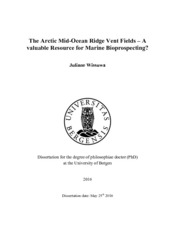| dc.contributor.author | Wissuwa, Juliane | |
| dc.date.accessioned | 2016-08-24T12:16:18Z | |
| dc.date.available | 2016-08-24T12:16:18Z | |
| dc.date.issued | 2016-05-25 | |
| dc.identifier.uri | https://hdl.handle.net/1956/12676 | |
| dc.description.abstract | The past decade the awareness for sustainability has come more and more into focus of society in terms of a need for eco-friendlier processes and renewable energies, new and better pharmaceuticals, and agricultural- and aquaculture challenges amongst others. Hence, enzyme technology has emerged as one of the most important technologies to meet future demands. A common consensus is that the marine environments represent a largely untapped potential for industrial applicable enzymes. As deep-sea hydrothermal vent fields have revealed a biodiversity of largely uncultivated microorganisms they have been reviewed as hot spots for finding new biocatalysts. In this study, samples from the Arctic Mid-Ocean- Ridge (AMOR) deep-sea hydrothermal vent fields have been investigated as a source for potential carbohydrate degrading biocatalysts, with a focus on starch degrading enzymes, using a multifaceted approach; isolation of a novel starch degrader (Paper I), integrated sequenced-based meta-omics study of a microbial biofilm (Paper II), genomic analysis of microbial isolates (Paper I and III), and finally, a functional-based screening of a microbial biofilm was conducted (described in detail in section 3.2). In general, the sequence-based screening for glycoside hydrolases (GHs) in all sequencing analyses was low, with Lutibacter profundi LP1T exhibiting the highest amount with 24 GHs (Paper III). However, a purified thermophilic neopullulanase with a melting temperature of 76.4 °C showed a comparable starch degradation capacity as the reference α-amylase from Bacillus licheniformis (Paper I). In comparison, a higher amount of proteases was identified searching against the MEROPS protein database. For both isolates (Paper I and III), protease activity was confirmed on agar plates hydrolysing casein and gelatin. Interestingly, the activity-based screening of a microbial biofilm identified 274 clones with starch degrading activity. Selective sequencing of 106 positive clones did not reveal any homologs of known α-amylases or members of the GH13 family. Further investigations of the clones are needed; however, this observation could be the first step in identifying new amylases yet to be characterized. The biofilm used in this study (Paper II and activity screening, section 3.2), attached to a deep-sea black smoker chimney, gave us the opportunity to investigate the trophic relationship between a biopolymeric producing filamentous Epsilonproteobacteria with organotrophic consumption of an epibiotic Bacteroidetes. Genomic characterization of an isolated Bacteroidetes from the biofilm further strengthened the link between primary production and the role of organotrophic degradation within the biofilm (Paper III). Besides exploiting metagenomics for bioprospecting, the comprehensive data obtained in my thesis enabled an expansive insight to functional and metabolic traits and linking them to taxonomical groups. The individual approaches provided different information, which combined contributed to our understanding of interactions in deep-sea hydrothermal food webs. | en_US |
| dc.language.iso | eng | eng |
| dc.publisher | The University of Bergen | en_US |
| dc.relation.haspart | Paper I: Wissuwa J, Stokke R, Fedøy AE, Lian K, Smalås AO, Steen IH. (2016): Isolation and complete genome sequence of the thermophilic Geobacillus sp. 12AMOR1 from an Arctic deep-sea hydrothermal vent site, in Standards in Genomic Science 11:16. The article is available at: <a href="http://hdl.handle.net/1956/11965" target="blank">http://hdl.handle.net/1956/11965</a>. | en_US |
| dc.relation.haspart | Paper II: Stokke R, Dahle H, Roalkvam I, Wissuwa J, Daae FL, Tooming-Klunderud A, Thorseth IH, Pedersen RB, Steen IH. (2015): Functional interactions among filamentous Epsilonproteobacteria and Bacteroidetes in a deep–sea hydrothermal vent biofilm, in Environmental Microbiology 17(10). Full text not available in BORA due to publisher restrictions. The article is available at: <a href="http://dx.doi.org/10.1111/1462-2920.12970" target="blank">http://dx.doi.org/10.1111/1462-2920.12970</a>. | en_US |
| dc.relation.haspart | Paper III: Wissuwa J, Le Moine Bauer S, Steen IH, Stokke R.: Complete genome sequencing of Lutibacter profundi LP1T isolated from an Arctic deep-sea hydrothermal vent system. Standards in Genomic Sciences. 2017;12:5. The article is available at: <a href="http://hdl.handle.net/1956/17523" target="blank">http://hdl.handle.net/1956/17523</a> | en_US |
| dc.subject | Atlanterhavsryggen | NOB |
| dc.subject | Bioprospektering | NOB |
| dc.subject | Hydrotermale skorsteiner | NOB |
| dc.subject | Arktis | NOB |
| dc.title | The Arctic Mid-Ocean Ridge Vent Fields - A valuable Resource for Marine Bioprospecting? | en_US |
| dc.type | Doctoral thesis | |
| dc.rights.holder | Copyright the Author. All rights reserved | en_US |
| dc.identifier.cristin | 1372365 | |
